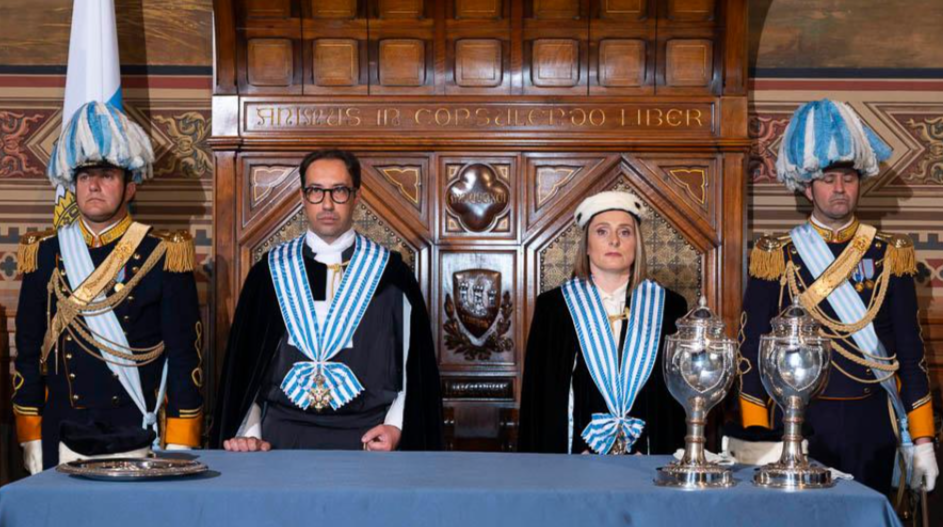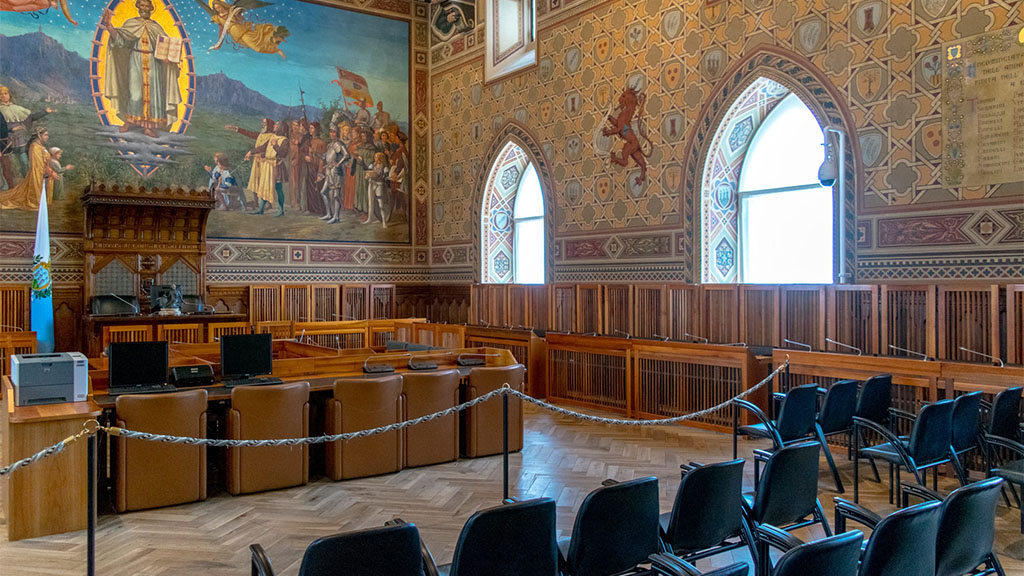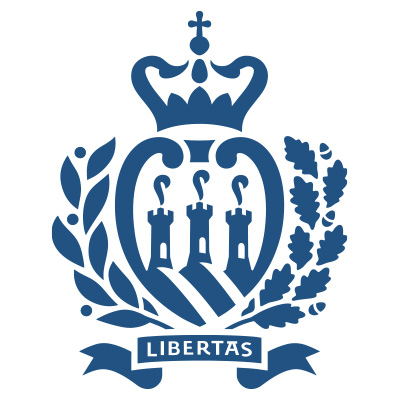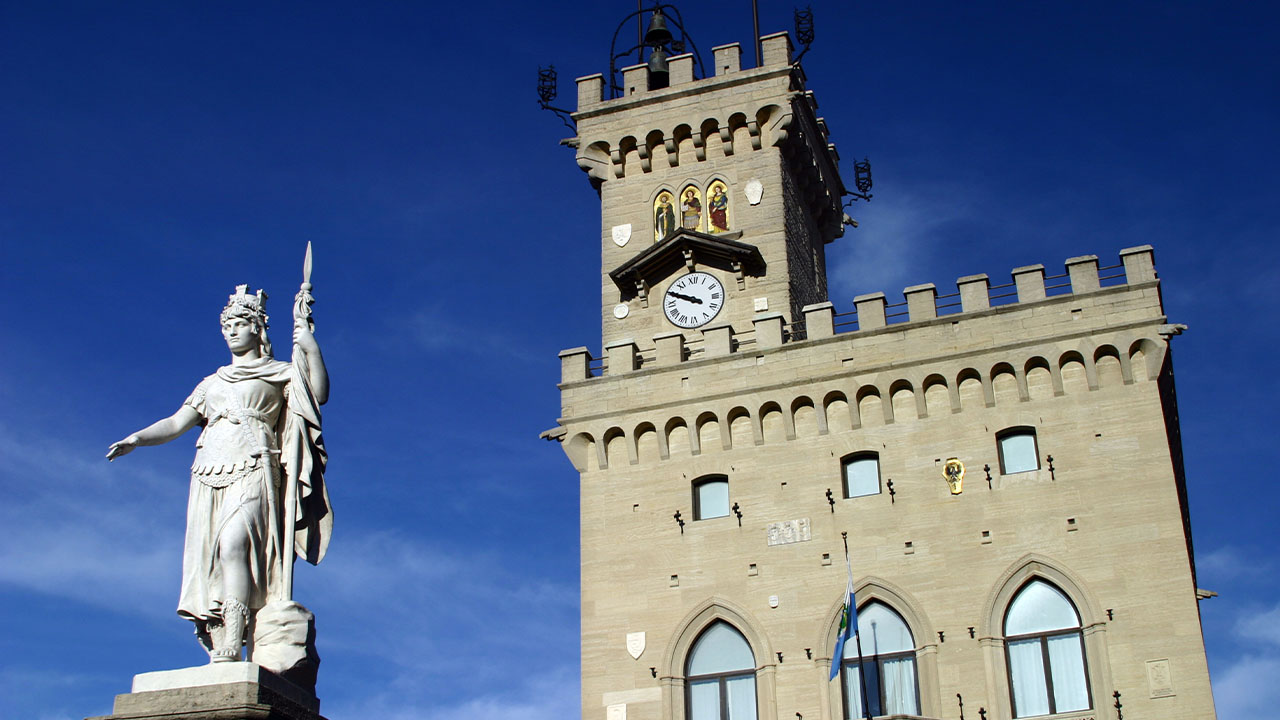The Republic of San Marino is the third smallest state in Europe (after the Holy See and Monaco) and the oldest Republic in the world. Its institutions, which have been survived throughout the centuries, are distinct and autonomous.
Their Excellencies the Regents
The Republic of San Marino’s Regency Institute is very old, and almost certainly began in the Communal period. The first time we hear mention two San Marino Regents (Filippo da Sterpeto and Oddone Scarito) is on a document dated 12 December 1243, though at that time they were not known as Regents, but as consules, meaning consuls, like the ancient Roman magistrates.
In the second half of the 13th century, other traces of Regents appear. As now, they remained in the office for six months. At the end of the century, they changed the name, becoming one Captain and the other Defender, while always maintaining their previous characteristics.
Over the years, they were given the title of Captains Regent, which they still have today, preceded by “Their Excellencies”. The Regents have always been appointed from within the Great and General Council, though through the centuries, various systems have been devised for their appointment.
Ever since the statute of late-1200, their term of office has been six months. Over the centuries, on rare occasions, this period has been extended, though the fact is that in San Marino, the danger has always been avoided of leaving one or more individuals as heads of state for too long, in order to prevent the risk of anyone person wielding enough power to suffocate the joint-power of the Council.
The Regents are appointed every six months by the Great and General Council and the two persons are elected who obtain the absolute majority of votes. Being members of political parties, they are generally elected according from among the parties forming the government coalition, or in any case on the basis of the suggestions of the parties sitting in the Council.
The ceremony, called the “entry ceremony”, is staged on April 1 and October 1 of each year with civil and religious celebrations. When, in the past, no political parties existed (parliamentary sessions only began in San Marino in 1906), the Regents were elected on the basis of the social class to which they belonged, because the Council consisted of 20 nobles, 20 landowners (meaning living on or at the foot of the mountain), and 20 inhabitants of the townships (rural settlements).
Today, the two Captains Regent jointly exercise the functions of Heads of State and Government, albeit sometimes symbolically, in all State institutions, and represent the complex constitutional power. Among the powers of the institution are: promulgating laws, directing and coordinating the procedures that precede the formation of the Government (meaning the State Congress), presiding over the major bodies (Great and General Council, State Congress, Council of the XII).
The Regents represent a “super partes” body guaranteeing the constitution. Their duties include, at times of government crisis or absence, talking with the political parties to determine the possibility of forming a new government coalition, or convening political meetings. Moreover, in case of need or urgency, they have the power to pass laws through Regency Decrees, even though such decrees must be ratified within three months by the Great and General Council. Finally, they are the only body responsible for promulgating laws (executive power), with the consequent possibility of exercising a sort of formal control on the work done by the Council.

The Great and General Council
The Great and General Council can be considered the “San Marino parliament”, is mentioned in documents dating back to the 13th century; in that period, it almost certainly shared power and control of the small San Marino community with other political bodies such as the Arengo and the Council of the XII and consisted of sixty members.
During the course of the centuries, the Council was the most powerful authority in the country, to the extent that the 17th-cent. statutes call it “the supreme, absolute and only prince” of the State.
Until the 17th century, it was the Arengo (i.e., the assembly of San Marino family heads) that periodically elected the councillors, but the 17th-cent. statutes established that the Council should directly appoint its new members by co-option.
This rule resulted in the gradual establishment of an oligarchic government in the hands of the main San Marino families, a system that lasted until 25 March 1906 when, after years of dispute and requests to restore an elective council system, by popular demand, the Arengo of the heads of the family was convened (after having been set aside for over three centuries) to decide whether to leave the situation as it was or make it more democratic. The majority opted for periodical elections, and from that year on, the Council was renewed by the citizens every three years, and then every five.
In the past, the Council had consisted of twenty members of all San Marino social classes (nobles, citizens, countrymen), while today it is formed of representatives chosen from among the electoral body at the proposal of the different local political parties, during the electoral campaign normally held every five years.
After the population expresses its vote and appoints the 60 members, the Council takes office and gives life to a new legislative body. The Council periodically convenes to examine and debate the items on the agenda, i.e., a series of items of various kinds relating to the management of the State. It is chaired by the Regency, with the assistance of the Presidency Office, which is a political body consisting of various councillors with the task of drawing up the agenda, and looking after the organisation of the meeting before and during its staging.
Its fundamental function is legislative because it is the body that draws up and approves all State laws. Another of its primary functions is political-administrative; in fact, the Council determines the constitution of the government after approving its political programme and monitors to ensure it always governs in compliance with the laws. The Council also appoints the Regents, the magistrates, the diplomatic representatives, and all the members with political duties, or who occupy highly-responsible positions within the San Marino State.
It is also charged with approving the annual preliminary State budget.
Specific requisites are needed to be appointed councillor: e.g., be 21 years of age or more, be domiciled in the Republic, have a spotless criminal record, not be a magistrate, not belong to any military corps.

The State Congress
The State Congress, coordinated by the Captains Regent, wields the power of government according to principles of collectiveness and responsibility. This state body was established by law on 15 May 1945. Constitutional Law no. 183, dated 15 December 2005, indicates and regulates its powers, while Law no. 184 dated 15 December 2005 regulates its organisation and operation, identifying eligibility requirements, appointment procedures, the incompatibility and removal from office of its members. Law no.184/2005 also regulates normal administration.
Congress consists of 10 Secretaries of State in charge of the various departments of the public administration. The members of the State Congress are appointed by the Great and General Council, normally from among its members.
Starting in the 26th Legislature, the possibility has been envisaged of appointing Secretaries of State – with the majority vote of two-thirds of the members of the Great and General Council – who must account for not more than one-third of the members of the State Congress and can also be non-members of the Great and General Council, as long as they have the requisites needed to be elected Councillors. After being sworn in, the State Congress becomes fully operative.
The term of office of a Secretary of State cannot exceed 10 consecutive years and, before any subsequent appointment, at least five years must have passed since the end of the previous one. The delegation of power to the single Secretaries is flexible. The body ceases operating if the majority of the members resign or if the Council resolves to revoke the appointments of all the members.
The Congress is in fact politically responsible to the Great and General Council. The discontinuance of the Congress does not imply early elections. The Congress is chaired by the two Captains Regent, who are not entitled to vote, but simply coordinate, direct and prompt proceedings and represent a link with the legislative body.
Council of the XII
The Council of the XII is a peculiar feature of the San Marino legal system which dates back over the centuries to the communal period when it wielded very important political and government powers.
With the 17th-cent. statutes, these powers were limited and more precisely defined, though some confusion still remained as to the council’s institutional role. In 1921 and ’23 laws were passed indicating it was to be considered a judicial and administrative justice body, with authority within these ambits. It nevertheless represents a totally original institution within the San Marino form of government, to the extent that its juridical nature is hard to define, considering also that, until a short while ago, it had both executive and juridical authority; it has since been deprived of the latter.
Before the establishment of the Constitutionality Guarantor Board, it was the Council of the XII which took decisions relating to civil third appeals; (whenever a second-degree sentence changed a first-degree sentence, including partially, the Council of the XII, normally with the aid of an expert appointed by the Council itself, was responsible for confirming the first or the second sentence).
As regards the administrative sphere, it authorises, for example, the purchase by foreigners of property or other real property rights relating to assets located within the Republic, it authorises the purchase of property by companies or other bodies corporate, it resolves in relation to applications for legal aid.
The Council of the XII is elected by the Great and General Council at the beginning of each legislature, and must necessarily consist of twelve members. There are no explicit incompatibilities, though by custom State Congress members are not normally elected. It is chaired by the Captains Regent, who have the right to vote only if they are members of the Council itself.
The Constitutionality of the Provisions Guarantor Board
Established by constitutional law no. 36 dated 26 February 2002 and subsequently regulated by law no. 55 dated 25 April 2003, it has a substantially dual function – of a constitutional and jurisdictional nature. Part of the former is the Syndicate of Constitutional Legitimacy of the Provisions, to be exercised in an incidental and a direct way, the Regency Syndicate, the Judgement of Acceptability of Referendums, and the Decision on Conflicts between Constitutional Bodies.
Part of the latter on the other hand are the jurisdictional functions of the Guarantor Board: the judgement on Jurisdiction conflicts, the judgement on the Abstention and Objection of the Magistrates, Third Appeal judgement in Administrative and Civil judgements, with function attributed to the Judge for the Third Appeal, and the decision on petitions for the revision of criminal sentences attributed to the Judge for Extraordinary Remedies who is also responsible for judgements on Querela Nullitatis remedies.
A Guarantor Board member is also competent to decide in the last petition as regards appeals presented in criminal proceedings and concerning the legitimacy of real and personal cautionary provisions adopted during the course of judgement or execution of the sentence.
The Township Councils
In times gone by, the Republic of San Marino was split into ten “Gualdarie”. This had practical purposes – the protection of the natural environment, of rural properties, and the maintaining of law and order.
In 1463, San Marino was extended by annexing various townships, called Communes or Castles, including Serravalle, Montegiardino and Faetano, all of which were granted administrative independence. Each of the three Townships was run by a Captain appointed by the Regency.
Today, thanks to a law passed in 1925, the country is split into nine areas. Each area takes its name from its largest town or Township: Città, Borgo, Serravalle, Acquaviva, Chiesanuova, Domagnano, Faetano, Fiorentino, Montegiardino.
Each Township has a Town Council, with strictly local duties tied to the control and management of services, the promotion and coordination of cultural, recreational or social activities, the maintenance, planning and realisation of public works, parks, etc.
The Councils are chaired by a Township Captain and consist of a varying number of councillors, depending on the size of the Township (9 for the Townships with over 2000 inhabitants, 7 for the smaller Townships). These are normally elected every five years by direct vote of the electors resident in the single Townships, or whenever the councils are dissolved or expire.
The Arengo
Though we know little about the early history of the San Marino community, it is likely that major decisions were taken during meetings in which members of all the families took part, meaning that political powers were not delegated to anyone and that a direct-democracy system was operative.
In this meeting, historically known as “Arengo”, all the heads of the family of the country took part and, until the 16th century, it was the power-wielding body of the tiny San Marino community.
We know that self-government was entrusted to the Arengo in the year 1000 and that the body detained all the legislative, executive and judicial powers previously wielded by the feudal bishop.
While the population remained small, the Arengo was operative and deliberative; when the population started to grow, however, the need was felt to create other smaller and easier-to-convene political bodies, that could reach faster decisions.
The growth of the community called for the setting up of a large decision-making body: so it was that in the 13th century, political assemblies were created (the Council of the LX and the Council of the XII). In 1243, the role of Captains Regent (Heads of State) was introduced. Elected by the Arengo, they wielded executive and judicial powers. The first laws date back to 1263.
The Great and General Council was set up in the 15th century. This consisted of 60 members of the Arengo, who were assigned a number of the assembly’s prerogatives. The new institutional bodies gradually took over most of the Arengo’s privileges. The latter, though never officially abolished, but now powerless, was no longer convened after 1571.
The Council of the XII and the Council of the LX gradually took over the powers of the Arengo, but without ever officially abolishing it. On 8 October 1600, the first written constitution was promulgated, the Leges Statutae Republicae Sancti Marini, which continues to remain at the bottom of the sources of San Marino Law.
Afterwards, the institutions underwent a process of deterioration. The Great and General Council, no longer under any form of control, became the instrument for protecting the interests of an increasingly smaller number of patrician families. The Council in fact ceased to be elected by the Arengo, but was renewed by co-option.
From that time, the Arengo, as a meeting of heads of family, was no longer convened until 25 March 1906, the date a big change came about thanks to a peaceful revolution which re-established the re-electability of the members of the Great and General Council.
On 25 March, the Arengo was convened to decide whether power should remain in the hands of the Council controlled by the oligarchy and whether the composition of the Council ought to be proportionate between the inhabitants of the countryside and those of the city. 805 heads of family out of a total of 1054 take part in the Arengo.
After the Arengo of 5 May 1906, an electoral law was passed requiring one third of the Council to be renewed every three years. This put a stop to its control by the oligarchy which, in the early part of the century was deprived of almost all its powers.
The Arengo took on a different role compared to the one it had had originally. In point of fact, it became a moment of community participation held twice a year, in April and October, at the same time as the election of the new Captains Regent.
Through the new Regents, each head of the family could send petitions and requests of public interest to the Great and General Council. It, therefore, lost all its deliberating functions and all control over the other political assemblies and this opened the path to the oligarchy of the Council of the LX until 1906, when it was revived with referenda functions and, as has already been said, opened the way to a new political period for the Republic.
In this guise, the Arengo still exists today; twice a year, San Marino citizens can send the Council, always through the new Regents, the so-called applications of the Arengo, petitions of public interest by means of which anyone can submit to the San Marino parliament non-personal problems of interest to the community as a whole. Within one month, the Regents must decide whether such applications are acceptable. If they are, they must be debated by the Council within six months from their presentation.
The people of San Marino make widespread use of this institute by means of which the Great and General Council is prompted to address problems closely affecting the public.

